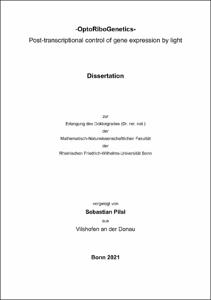Pilsl, Sebastian: OptoRiboGenetics : Post-transcriptional control of gene expression by light. - Bonn, 2021. - Dissertation, Rheinische Friedrich-Wilhelms-Universität Bonn.
Online-Ausgabe in bonndoc: https://nbn-resolving.org/urn:nbn:de:hbz:5-63248
Online-Ausgabe in bonndoc: https://nbn-resolving.org/urn:nbn:de:hbz:5-63248
@phdthesis{handle:20.500.11811/9283,
urn: https://nbn-resolving.org/urn:nbn:de:hbz:5-63248,
author = {{Sebastian Pilsl}},
title = {OptoRiboGenetics : Post-transcriptional control of gene expression by light},
school = {Rheinische Friedrich-Wilhelms-Universität Bonn},
year = 2021,
month = aug,
note = {Gene expression is tightly regulated in mammalian cells at the post transcriptional level and its precise manipulation has proven to be valuable for protein overexpression and gene therapy. Implementation of light-responsive photoreceptors into gene regulatory networks has been shown to enable spatiotemporal control modalities. The discovery of the bacterial light-oxygen-voltage (LOV) photoreceptor PAS-ANTAR-LOV (PAL) depicts a direct link between light-control and RNA biology and, thus, led to the foundation of optoribogenetics. Light-adapted PAL binds RNA stem-loop structures in a sequence dependent manner via its ANTAR domain.
The control of gene expression as a function of light was achieved in mammalian cells when PAL-binding stem-loops were embedded in 5’ untranslated regions (UTRs) of mRNA transcripts. Increased light-control was achieved when PAL was fused to eukaryotic translation initiation factor 4E binding protein 1 (4E-BP1), an inhibitor of cap-dependent translation. Besides these "off-switches", "on-switches" were generated when PAL-binding stem-loops replaced the apical loop domain of pre-micro RNAs (pre-miRs) or short-hairpin RNAs (shRNAs). The performance of shRNAs was improved via single nucleotide insertions that conjoin the small-interfering- (si-) RNA to the PAL-responsive RNA stem-loops. Such shRNAs can be designed and applied in a near-arbitrary fashion with minimal efforts as exemplified by controlling the physiologic function of several target proteins.
Taken together this thesis presents optoribogenetic methodologies which offer a hitherto unavailable access point that connects light-mediated precision with RNA biology in a genetically encodable system. These methods will facilitate the study of RNA and protein function in vivo. As next step, they could be used in future gene therapies or in basic research, for example to study the onset of cancer.},
url = {https://hdl.handle.net/20.500.11811/9283}
}
urn: https://nbn-resolving.org/urn:nbn:de:hbz:5-63248,
author = {{Sebastian Pilsl}},
title = {OptoRiboGenetics : Post-transcriptional control of gene expression by light},
school = {Rheinische Friedrich-Wilhelms-Universität Bonn},
year = 2021,
month = aug,
note = {Gene expression is tightly regulated in mammalian cells at the post transcriptional level and its precise manipulation has proven to be valuable for protein overexpression and gene therapy. Implementation of light-responsive photoreceptors into gene regulatory networks has been shown to enable spatiotemporal control modalities. The discovery of the bacterial light-oxygen-voltage (LOV) photoreceptor PAS-ANTAR-LOV (PAL) depicts a direct link between light-control and RNA biology and, thus, led to the foundation of optoribogenetics. Light-adapted PAL binds RNA stem-loop structures in a sequence dependent manner via its ANTAR domain.
The control of gene expression as a function of light was achieved in mammalian cells when PAL-binding stem-loops were embedded in 5’ untranslated regions (UTRs) of mRNA transcripts. Increased light-control was achieved when PAL was fused to eukaryotic translation initiation factor 4E binding protein 1 (4E-BP1), an inhibitor of cap-dependent translation. Besides these "off-switches", "on-switches" were generated when PAL-binding stem-loops replaced the apical loop domain of pre-micro RNAs (pre-miRs) or short-hairpin RNAs (shRNAs). The performance of shRNAs was improved via single nucleotide insertions that conjoin the small-interfering- (si-) RNA to the PAL-responsive RNA stem-loops. Such shRNAs can be designed and applied in a near-arbitrary fashion with minimal efforts as exemplified by controlling the physiologic function of several target proteins.
Taken together this thesis presents optoribogenetic methodologies which offer a hitherto unavailable access point that connects light-mediated precision with RNA biology in a genetically encodable system. These methods will facilitate the study of RNA and protein function in vivo. As next step, they could be used in future gene therapies or in basic research, for example to study the onset of cancer.},
url = {https://hdl.handle.net/20.500.11811/9283}
}






